Some might consider cleaning vinyl to be on the more prosaic side of sailing. But if you’re trying to keep your boat and equipment “squared away,” cleaning vinyl is an important item on the chores list. When these little things get addressed, it reflects well on both ship and master.
Optimistically, we hope for an all-purpose cleaner. More realistically, most cleaning is about matching the cleaner to the soil, while limiting ourselves to chemicals that won’t damage the substrate. You need to know what you are removing from what.
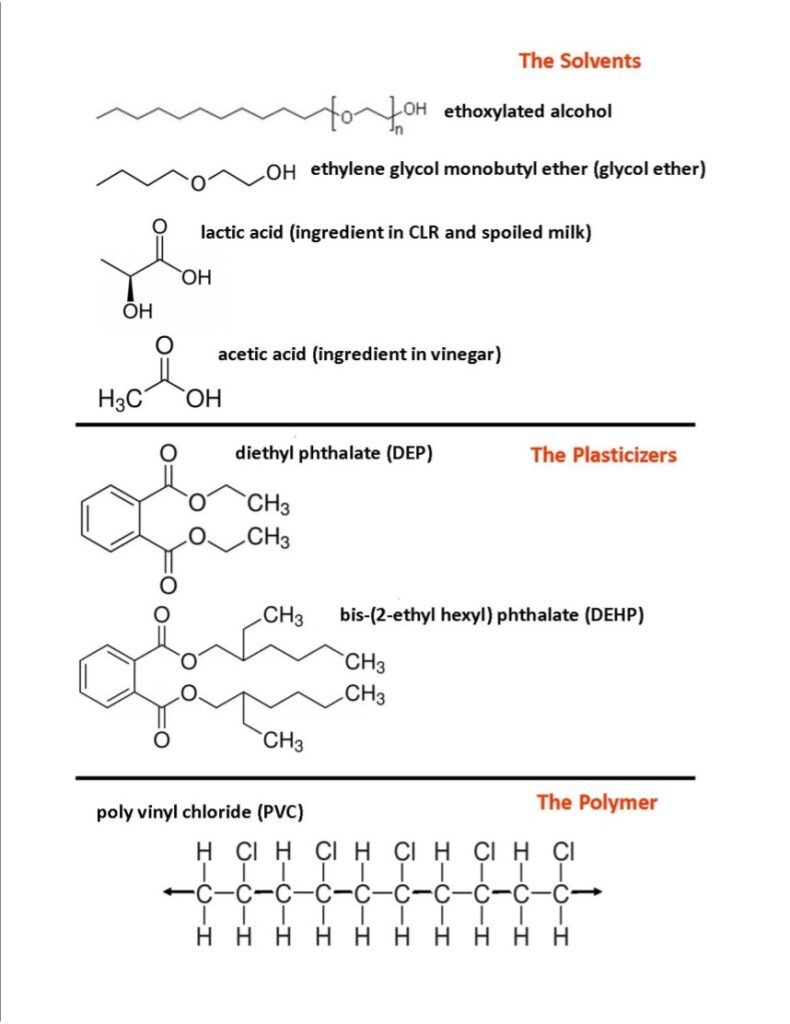
PVC is great stuff for many marine applications. Inexpensive, immune to seawater and many chemicals, and resistant to UV if formulated with the right inhibitors. It can be opaque and rigid, like PVC pipe, if filled with minerals to increase stiffness and strength. It can be soft and clear, in the case of PVC windows, if compounded with plasticizers and coated with a urethane film for UV and abrasion resistance. In the case of fenders, plasticizers, UV inhibitors, and pigments result in a flexible, tough plastic that can withstand being smashed against a dock for years, suffering only minor abrasions and getting dirty. Frequent cleaning (every few months) keeps the soil from becoming deeply embedded and will remove plasticizer bleed as it emerges, which will reduce dirt. Most of the dirt is just cosmetic, and dark glasses or dark fenders solve that problem, but it can also transfer to the hull, and that is a problem.
FIRST, SOME PROTOCOL
In addition to frequent cleaning, don’t leave them in the water. Tannin stains can go deep and are hard to remove. Algae grows, and if there are any cracks the roots go deep. It also provides moisture and shelter to mildew fungus, the champion at penetrating deep into weathered plastic. Lime deposits into the algae, making it abrasive. Barnacles can grow.
Avoid pilings with tar. In fact, anytime you can fit a fender board it will help keep the fenders clean. Once dirt is ground in, cleaners can’t reach it. Fender covers can help, but you need two sets and must be committed to laundering them every few weeks. Otherwise, they will become more abrasive than the dirty fender because they hold water, which attracts algae, lime, and tannin. They do reduce UV damage. Note: Xylene is the best bet for removing tar from gelcoat, though it is not effective on other soils.
Protectants help, but not because they screen UV. That’s hokum. There is no third-party research supporting the claim.. PS has tested waxes for UV screening, and unless you plan on re-applying weekly, equivalent to applying sunscreen every few hours, they don’t work. But they do seal pores, keeping dirt and oxygen on the outside. For example, they didn’t prevent UV damage during vinyl window testing, but they did reduce fogging in extremely humid conditions. So while wax will only extend the life of vinyl a very little bit, it will keep it looking better by preventing stains from penetrating. It doesn’t slow plasticizer bleed, because it is no more impervious to plasticizer migration than the plastic, but it can seem that way, because every time you wax you clean the surface. Waxes and protectants often claim to improve suppleness, but we’ve tested that and found that this is just not even slightly true. The waxed surface feels more supple, but we measured stiffness and fracture resistance and there were no changes.
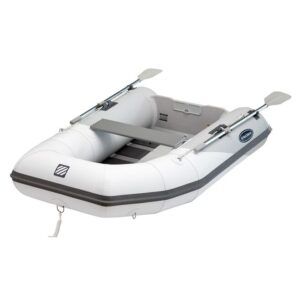
Painting PVC before the PVC bleed becomes apparent may slow the bleed by sealing the surface. We strongly recommend painting PVC dinghies at or before about 10 years. Another alternative is fabric chaps. We recommend a good scrubbing with Pine-sol, Sudbury Bilge Cleaner, or better yet, the PS DIY formula (see sidebar) before painting any PVC item. Examples include inflatable dinghies, PVC coated tape,or net trampolines. If the plasticizer is not removed it will interfere with the cure and the paint will remain sticky forever. It’s sort of like leaving epoxy amine blush in place, only much harder to remove. Although we strongly advise against painting fenders, we heard good things about SEM products for refinishing cushions that have faded or gotten sticky. After cleaning as above, paint 2-3 coats with SEM Vinyl Coat, and then 1-2 coats of SEM Tac Free. Developed for refinishing automotive parts, where plasticizer bleed is a big problem, the Tac Free Finish coat is said to prevent the stickiness from returning. Or at least that is what our doc mates say, based on three years of weathering.
WHAT ABOUT PAINT?
Paint prevents UV damage, but it’s a bad choice for fenders. Flexible vinyl does not take paint very well and commonly flakes off. Worse yet, plasticizer bleed can make the paint sticky, and then it transfers to the hull. Very bad.
Plasticizers are polymer-soluble chemicals added to the formulation to act as sort of an internal lubricant, softening the plastic. However, since part of their function is to prevent the polymer molecules from consolidating into strong crystal-like groupings, they must be slightly different from and not comfortably soluble in the resin. As a result, they very slowly migrate out of the plastic and toward the surface. If the surface is cleaned frequently enough, with the right sort of cleaner, they never accumulate enough to be noticeable. If plasticizer accumulates enough to start feeling sticky, it attracts dirt and is not easy to remove. The dirt also has time to work its way deeper inside the plastic. Unfortunately, cleaning fenders is a high-work, low-reward task.
First, we need to understand what we are trying to remove. Not all soils respond to the same cleaner.
Metals and tannin staining. Brown to black stains, most common in brown-water sailing areas, such as the Chesapeake Bay, southeast, and Gulf Coast. Acid cleaners remove them, alkaline cleaners just set the stain, and solvents don’t do anything. Bleach is only moderately effective on tannin and can make metals corrosion stains worse. Extreme pH cleaners, either alkaline or acid, will kill it and remove it from the surface, but if it is deep into the cracks, they can’t reach it, neither can bleach. It’s permanent.
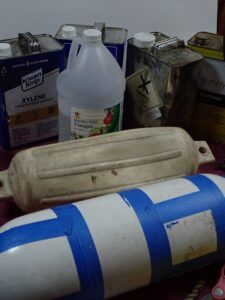
Tar from commercial docks. Mineral spirits or VM&P naptha (lighter version) does a good job without damaging the PVC. Xylene works, but it can also melt the surface. Glycol ethers are good at dissolving it, when combined with other cleaning agents.
Lime and salt encrustations. Acid cleaner, like citric acid or vinegar.
Plasticizer bleed. A combination of acid and glycol ether is best.
Sun hastens plasticizer bleed. Part myth, part truth. The sun adds heat and heat speeds diffusion of the plasticizer through the plastic. But we’ve also had items such as ski boots, gloves, and raingear go sticky and brittle when stored in the dark.
CLEANERS TO AVOID
Solvents are not our preferred approach. They can pull up more plasticizer from within, because they risk melting the surface and sealing some of the dirt inside, creating microcracks that speed weathering, and thus encouraging more deeply embedded dirt. On thin vinyl, leaching of plasticizers by cleaners can lead to premature brittleness and cracking.
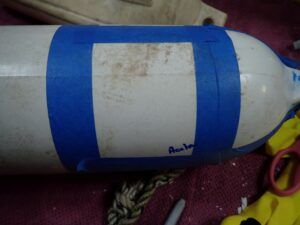
Clean is nice, but we aren’t going to recommend anything damaging, in part, because we’re sure some readers will use our recommendation on more delicate vinyl items, like upholstery, tenders, or even windows. Don’t use these:
Aldehydes (acetone) and ketones (MEK), or blends such as lacquer thinner that contain them. They work by dissolving the surface layer. Additionally, because they actively leach plasticizers from the surface layers, they can harden the surface, encouraging micro-cracking, which leads to encrusted dirt and stuff you can’t clean. Fast results, long term harm.
Ammonia and amines. They lead to microcracking.
Aromatics, including xylene, gasoline, and turpentine.
Esters, including ethyl acetate. Acetates are sometimes used as denaturing agents in alcohol; if the denatured alcohol smells sweet or like acetone, it is not PVC-safe.
Ajax, Bon Ami, Barkeeper’s Friend, Comet, Soft Scrub, Magic Eraser, and other abrasive-containing cleaners will roughen the surface and make it more porous, accelerating the return of stains.
Alkaline cleaners. Not because of damage, but because, in general, they don’t work. Spray Nine, for example, did poorly in PS testing. You need an acid cleaner from the family of soap scum removers.
WHAT DOES WORK?
Before getting to our top choices, let’s talk about things you can use that have some effectiveness, depending on the soil.
- Paraffinic solvents, including mineral spirits and kerosene. Good for tar.
- VM&P naphtha. Contains some aromatics, but is generally OK. Good for tar.
- A natural mildew killer, but not much else.
- OxiClean is a possibility, but even with a soak it didn’t seem to do much for mildew in plastics. Save it for brightening fabrics.
- Will remove some surface soils, but not tar, mildew, or plasticizers.
- Most organic acids, including acetic, lactic, glycolic, and citric, but not strong acids in general and specifically avoid sulfuric acid, which can stain.
What works for plasticizers, algae, and tar, are acid cleaners formulated with glycol ethers. A general rule is that like dissolves like, and thus the organic acid/glycol ether combination is the most effective combination for removing plasticizer bleed, even more effective than strong and damaging solvents, but without the risk.
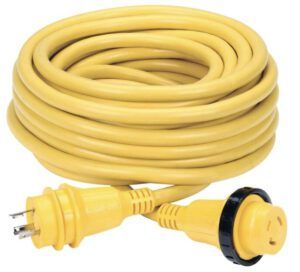
It strong stuff. It is a concentrate and should be diluted five or ten to one for most cleaning. EGBE (glycol ether) 40% vinegar 50% water 10% Organic acids dissolve the lime that makes algae and hard water stains so tough. They are also safe for vinyl and can remove plasticizers by matching up with the acid group in the molecules. But the action is slow on its own. EGBE (glycol ether) is a strong co-solvent, helping to pull the longer oily chains into solution. That’s why it’s in Formula 409 and Boat Goat. We settled on vinegar after testing with lactic acid (CLR) and citric acid, which were slightly less effective. The usual surfactant blend, for removing grease and atmospheric grime is not needed or helpful with these high levels of EGBE and acid. This product can be used at full strength for the most severe cases, but in most cases should be diluted 5:1 to 10:1 with water for economy and to reduce exposure. This is a concentrate. The concentration of acid and glycol ether is unusually high, nearly 10 times that of old school Formula 409. We recommend full strength for severe plasticizer bleed and ground-in tar, but diluted with up to 10 parts water for most uses. Glycol ethers have been widely used in cleaners for nearly 100 years, have been thoroughly studied, and have not been determined to be carcinogenic or bio-accumulative. Marine toxicity is moderate, and it is readily biodegradable. Thus, we believe this is safe for specific uses, but should be treated with the same sort of care you would a paint stripper. Work outside. Do not heat the product (fumes), wear gloves, and wear respiratory protections (solvent vapor cartridges) as needed, remembering that it lacks a strong odor and can become concentrated in the cabin or other confined space. You won’t find EGBE at the hardware store, but Amazon and others have it. The bottom line is that it cleaned better and several times faster than any other product we tried, across the widest range of soils. But it didn’t touch deep mildew. Diluted for lighter duty cleaning, it is also the least expensive option.
DEEP DIVE
What We Tested. We tested most common solvents, including acetone, lacquer thinner, xylene, mineral spirits. We tested both household and marine cleaners including Pine-Sol, Boat Goat, and a DIY concentrate formulated from vinegar and glycol ether.
How We Tested. We marked off the surface of several old fenders and several shore power cords with tape, and tested the solvents and cleaners.
Observations. Predictably, bleach removed some mildew stains, but not if they were deeply embedded and no better than the top acid cleaners. Lacquer thinner melted the surface a little and thus removed some grime, but we can’t recommend it. The only effective cleaners were Pine-Sol (weak acid plus pine oils as a co-solvent), Sudbury Bilge Cleaner, and our PS DIY Fender Cleaner (vinegar plus ethylene glycol monobutyl ether). Sudbury Bilge Cleaner was a surprise, the only alkaline product that performed at all. It is more concentrated than most (so you can dilute it) making it a good value. We like other Sudbury products (Boat Zope and Barnacle Blaster), so it seems they have a smart, marine-focused chemist.
See also https://www.practical-sailor.com/boat-maintenance/vinyl-cleaners-2 for a prior report.
In all cases there was some soil, principally mildew we think, so deeply embedded into the deteriorated PVC that nothing could touch it. On the other hand, there is also no chance that it will come off on the boat.
Summary. The best cleaner depends on the soil it is intended to remove, but in general acid cleaners (pH 2-4) with a co-solvent (glycol ether, pine or citrus oils) were the best all-around. We suspect that most tub and tile soap scum products based on weak acids will be reasonably effective, but probably not as good as the PS DIY formulation either full strength for really tough cases, or diluted 5- to 10-to-one with water.
If a good scrubbing with one of these hasn’t removed the stain, it’s not coming off on your boat, and it might be best to look at it like a stain on the sole of your shoe; if it isn’t tracking in the house it doesn’t matter. Just as the function of luggage is to protect the contents, the purpose of fenders is to protect the boat. In both cases, a little wear and a few smudges tells people that you’ve been places.







































What about simple green?
Another option for painting fenders might be buoy paint (for lobster buoys up here in Maine). I have used solvent-based buoy paint to “refresh” white vinyl winch handle holders and cowl vents. It takes time to harden up to a tack-free surface, but once all the solvent is out, it lasts very well. The solvent-based paints are based on PVC resin, so intimately compatible with vinyl fenders (but requires strong solvent system). There are water-based buoy paints now as well, but I have not tried.
My personal preference is to buy black fenders and/or black cloth fender covers which simplifies matters quite a bit.
Along those lines, why doesnt Marinco and other power cord makers offer a black or dark blue power cord instead of the invariably dirty white or yellow.
Which brings up the question of why power cord covers are no longer available from Marinco. It wasnt like they were cheap. Fifty bucks or more for a few feet of canvas and thread.
One more thing. Tell me why two different manufacturer 20+year old expensive binoculars
are getting sticky.
The whatever black covering is sticky and I tried cleaning with alcohol to no avail. I suspect it is the slow death of my binocs.
On the vinyl cleaning formula for Vinyl…..
Our lifelines always get sticky. what I have done is use 409 and a blue scotchbrite pad to clean the them. I spray it on, with the scotchbrite under it (so it doesn’t get everywhere). let it sit for 30 seconds. then rub the scotchbrite over it. (after a couple segments, the scotchbrite is saturated and I can just use that without spraying more product) few strokes, the lifelines are clean and not sticky anymore. i get a couple months before the stickyness comes back.
Would the formula in the article be better than using 409? Is there a better application method ?
Is there a protectant I can put on to keep the stickyness from coming back, or at least slow it down ?
How does glycol ether PM (Propylene Glycol (Mono) Methyl Ether) compare to EGBE that is recommended?
We tested Simple Green. Not terrible, but not very good. It might work with enough elbow grease. A scrubbing head for a cordless drill (not plug-in–don’t electrocute yourself!) might help.
Paint can be the next step for dinghies. We’ve done that. Not sure I’d bother on a fender.
Dark colors make sense for cords. They seem to think sailors love white because we like white deck (cooler in the summer). However, I’ve never had dark fenders and I would worry about color transfer. Not a problem, I’m guessing?
The best solution to sticky lifelines is to replace them (I’m guessing they are quite old since they have not been done that way for quite a while) with bare stainless wire. They are doubtless past retirement age for a safety item. I’ve had old coated wire cable snap without warning (water gets under the coating, corrosion starts in the absence of oxygen, and snap). Alternatively, the coating can often be stripped with a razor knife with little effort (it sort of peals once started). If you uncover any corrosion, typically at the ends, replace it.
I don’t know about PGME. Test it. It is more volatile and thus is flammable and a greater inhalation risk. I think I would avoid it and cannot recommend it to our readers, without knowing their experience and training. But should still be compatible with vinyl.
The lifelines in my comment are 3 years old. the stickyness started right away, well, year 2. They clean up great with 409 and blue scotchbrite. I mean, they come out looking brand new, no stickyness, nice and smooth. Replacing them every 2 years will get quite expensive!
Since they are pretty new, I am wondering if I am doing harm , or should I switch to the PS formula in the sidebar. If they both have EGBE , is there an advantage/safety in one or the other, or will one harm the vinyl more than the other ? Or are both a bad idea and is there a better product/process?
It seems like the 409 dissolves the sticky part, and the scotchbrite mechanically removes it.
I also have used Westley’s Whitewall Cleaner for similar jobs in the past (vinyl upholstery). I am unsure if it has EGBE, or some other similar solvent/surfactant, is in it. Both 409 and westleys smell similar
I talk with other boaters, they all have different concoctions to handle sticky vinyl
Curious if there is a permanent fix?
I know I do not hold an exclusive on sticky vinyl. Might be worth a deep dive on best practices on this problem.
please respond to the previous question- were the tested solutions better than regular 409?
is the vinegar used in the DYI solution 20% high strength available in hardware store or regular grocery store 3%?